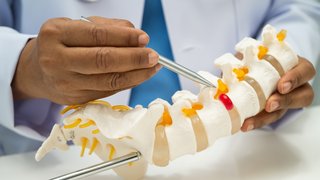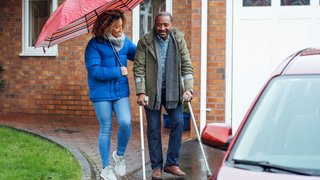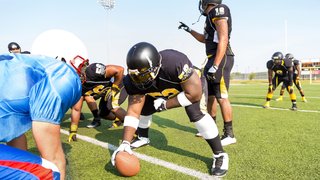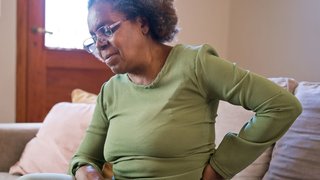After ACL injury, UFC star is back fighting for his family and his country
September 29, 2021
When Kennedy Nzechukwu steps into the Octagon, he isn’t just fighting for himself.
The 29-year-old UFC contender is the primary caregiver for his mother, who is battling ALS (amyotrophic lateral sclerosis), and his older brother, who is autistic. He also supports his younger sister, a college student in Dallas, and relatives back home in Nigeria.
A lot is riding on the young man’s broad shoulders and 6-foot-5, 230-pound frame.
So, when Kennedy felt something snap in his left knee during a training session in October 2019, he worried his career and his family’s future could be in jeopardy. “I was in agony, and I was like, ‘What if I’m done?” he recalled. “There was just a lot rushing through my mind.”
Kennedy was referred to the Sports Medicine Clinic at UT Southwestern Medical Center in Richardson/Plano, where we treat all levels of athletes, from professionals to weekend warriors.
An MRI showed Kennedy had torn his anterior cruciate ligament (ACL), the strong band of tissue that connects the femur (thighbone) to the tibia (shinbone) and provides stability to the knee. It was a complete tear.
In November, we performed reconstructive surgery on Kennedy’s knee, and then he embarked on a very specific and intense regimen of physical therapy at UTSW. About eight months later, he was ready to get back in the ring but by then the COVID-19 pandemic had sidelined most pro sports, and his comeback was delayed.
When Kennedy finally did return to the cage on March 6, 2021, he KO’d his opponent in the second round. A few months later, he won again with a third-round TKO.
“The knee feels stronger than ever!” Kennedy said recently. “I’m really grateful to UT Southwestern. They played a vital role in my rehab and really pushed me.
“Now, I am able to pursue my dream again.”
The art of ACL reconstruction
ACL injuries make up about 40% of all reported sports-related injuries and they are particularly common in basketball, football, soccer, and volleyball – sports that involve a lot of sudden stops, jumping, pivoting, and changes of direction. Blunt force trauma to the knee can also cause an ACL tear, and that’s what happened to Kennedy during a sparring session.

The ACL is unlike any other ligament in the body because it’s located entirely inside of the knee joint, which means that when it ruptures, the surrounding joint fluid dissolves the blood that would otherwise form a clot and initiate the healing process.
Nonsurgical treatments, including rest, anti-inflammatories, bracing, and rehab are certainly an option for less-active patients, but for an athlete of Kennedy’s caliber, and people who want to return to physically demanding activities, ACL reconstruction is the best treatment option.
UTSW’s Orthopaedic Surgery and Sports Medicine team performs hundreds of ACL reconstructions each year, and whether you’re a UFC fighter or a weekend tennis player, your surgical options are the same.
We reconstruct the torn ligament with a tissue graft that your body remodels into a new ligament. Working together, we’ll help you choose the best graft for your lifestyle and needs. Choices include:
- Allograft: Sometimes called a cadaver graft, the tissue is commonly taken from a donor’s hamstring, patella tendons, or Achilles’ tendon. Allograft involves less surgery and, in the early recovery stage, there may be less pain. But allografts have a higher retear rate.
- Autograft: Pro and elite-level athletes usually opt for an autograft, which involves taking tissue from their own quadriceps, hamstring, or patellar (kneecap) tendons, among others.
The patella tendon autograft is the only option that provides bone plugs on both ends of the tissue, making it possible to affix the plugs to small tunnels drilled in the upper and lower leg bones. In my opinion, this approach promotes faster, more predictable bone-to-bone healing.
After describing the possibilities to Kennedy, he agreed a patella tendon autograft would give him the best chance at a fast recovery. The arthroscopic surgery was done as an outpatient procedure and Kennedy was able to go home later the same day with a “new ACL.”
Physical therapy: ‘They had me sweating’

The surgical goal of ACL reconstruction is to tighten the knee and restore stability, but the bulk of your recovery comes during physical therapy and rehabilitation. For my patients, that starts the next day.
I tell them the surgery is essentially the same for everyone, the difference is how aggressively you attack your rehab. We have a team of Sports Medicine professionals (therapists, athletic trainers, nonsurgical and surgical orthopedic specialists) at your disposal who will work together to get your strength, agility, and range of motion back. And we’re not afraid to push you!
“They had me sweating profusely,” Kennedy joked. “I went there three times a week and it strengthened my knee in a short amount of time. They really know what they’re doing.”
I see patients throughout the rehab process, which can be anywhere from six months to a year. The type of graft you choose affects your recovery to some extent, but so does your dedication. The Sports Medicine team will chart your progress with a specific set of milestones:
- Recovering full range of motion
- Strengthening the muscles around the knee
- Returning to light jogging, followed by running and sprinting
- Beginning the jump-and-agility program, which includes lateral movements and pivoting
- Finally, we’ll conduct a battery of “return-to-sport” testing to make sure you’re ready for competition.
Once your reconstructed knee scores 90% of your uninjured knee on the return-to-sport testing, we clear you to resume all activities. However, we also caution you to gradually work toward your peak performance because it takes time to rebuild your strength and endurance.
For Kennedy, it took him about eight months to work his way back into competitive shape. For others, it may take longer. But our team will be there with you – pushing you – the entire way.
Getting your knee and mind ready

For many athletes, the final hurdle to clear after ACL reconstruction is a mental one. It’s difficult to perform at the highest levels until you trust your body again.
Kennedy doesn’t hesitate to tell people he was scared when he stepped back into the ring.
“It’s chaos in the Octagon, so I was worried,” he said. “When I got kicked that first time, it woke me up and my natural instincts took over. The knee held up perfectly, and I’m grateful for that.”
In many ways, Kennedy’s story is not unique. An ACL tear is a traumatic injury for any athlete. But knowing all he has been through – he’s literally fighting to support his family here and in Nigeria – Kennedy and his care team at UTSW felt confident that his faith and internal fortitude would get him back to the top of his sport.
He credits his mother, a former nurse who is suffering from the devastating neurodegenerative effects of ALS, or Lou Gehrig’s disease, with inspiring him along the way.
“She was very competitive as a youngster, very athletic, but she wasn’t able to capture her dreams in Nigeria,” said Kennedy. “That’s why she pushed me. She wanted to make sure it was possible for us to live our dreams.”











